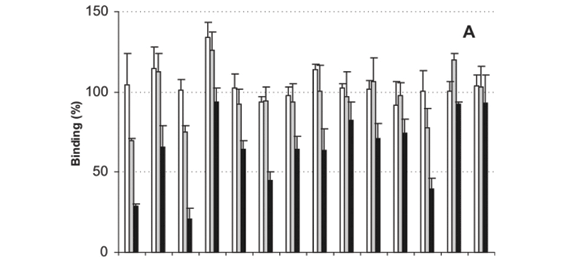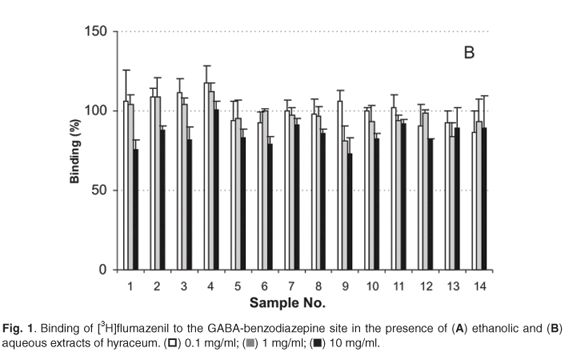Services on Demand
Article
Indicators
Related links
-
 Cited by Google
Cited by Google -
 Similars in Google
Similars in Google
Share
South African Journal of Science
On-line version ISSN 1996-7489
Print version ISSN 0038-2353
S. Afr. j. sci. vol.103 n.11-12 Pretoria Nov./Dec. 2007
RESEARCH IN ACTION
Hyraceum, the fossilized metabolic product of rock hyraxes (Procavia capensis), shows GABA-benzodiazepine receptor affinity
Andreas OlsenI; Linda C. PrinslooII; Louis ScottIII; Anna K. JägerI, *
IDepartment of Medicinal Chemistry, Faculty of Pharmaceutical Sciences, University of Copenhagen, Universitetsparken 2, DK-2100 Copenhagen O, Denmark
IIDepartment of Physics, University of Pretoria, Pretoria 0002, South Africa
IIIDepartment of Plant Sciences, University of the Free State, P.O. Box 339, Bloemfontein 9300, South Africa
ABSTRACT
HYRACEUM, AN ACCRETION OF URINE AND dung of rock hyraxes (also known as rock dassies), when fossilized with age, has been used in South Africa for the traditional treatment of epilepsy. We report on tests of 14 hyraceum samples, collected at various geographical locations in South Africa, and assayed for GABA-benzodiazepine receptor affinity. Ethanolic extracts of four of the hyraceum samples assayed positive, whereas all aqueous extracts were inactive. Qualitative TLC resolution of the ethanolic extracts shows a complex mixture of constituents, with no feature being a distinguishing pattern for all four active samples. These preliminary results are not in conflict with the traditional use of hyraceum as a treatment for epilepsy by the settlers of Gamkaskloof.
Introduction
Rock hyraxes (Procavia capensis) are rabbit-sized, tail-less mammal herbivores which are widespread on the African continent, where they inhabit shelters in rocky outcrops in a variety of biomes.1 They defecate and urinate in latrines, in which the urine and faecal pellets accrete to form dark brown, resin-like masses in which plant material, pollen and other digestive remains are trapped.2–4 These middens fossilize with time in the dry arid regions of South Africa, become metres thick and are known as hyraceum (Afrikaans dassiepis or klipsweet). This is sold as traditional medicine and is exported to France as a fixative in the perfume industry.
The Khoi (Hottentots) used powdered hyraceum to treat snake and scorpion bites, while a glutinous concoction from boiling the material with water has been used by oral administration as an antidote against poisons and as a cure for back and abdominal aches. Afrikaner settlers in Gamkaskloof, a remote valley in the Swartberge, which was accessible only on foot until 1963, used an infusion of hyraceum as treatment for various ailments, including colic, hysteria, epilepsy and St Vitus's dance (now known as Parkinson's disease).5
Epilepsy (or seizure disorder) is a common chronic neurological condition that is characterized by recurrent and sporadic epileptic seizures that arise from abnormal cerebral nerve cell activity. Epilepsy is linked to an imbalance in the GABAnergic system. γ-Aminobutyric acid (GABA) is the main inhibitory neurotransmitter in the mammalian central nervous system, exerting its physiological effects by binding to various GABA receptors. The GABAA receptor, which is implicated in epilepsy, also provides a binding site for benzodiazepines that allosterically modify the chloride channel gating of GABA. When a compound binds to the benzodiazepine site on the GABA receptor, it enhances the activity of GABA, thereby restoring normal brain activity and inhibiting seizures.6
In previous studies we screened various South African plants used by traditional healers to treat epilepsy for activity in the GABA-benzodiazepine receptor assay.7–9 We now use the same methods to attempt to understand the traditional use of hyraceum as a treatment for epilepsy by the settlers of Gamkaskloof.
Materials and methods
Collection of material. Samples were collected from the following South African sites (see Fig. A in supplementary material online at www.sajs.co.za): 1, Richmond in the Karoo; 2 and 3, Gamkaskloof; 4, Karoo National Park; 5, Van der Kloof Dam, Rolfontein; 6, Keerkloof, Anysberg; 7, Naauwhoek, Griekwastad; 8, Golden Gate; 9, Meiringskloof, Fouriesburg; 10, Stadsaalgrotte, Cederberg; 11, Wolfberg, Cederberg; 12, Pakhuis Pass, Cederberg 13, Naval Hill, Bloemfontein; 14, Oppermanskop, Naauwpoort. Samples 4, 8, 10 and 13 were unconsolidated whereas the other samples were solid and rock-like, as a result of impregnation with dried hyrax urine. The latter type is probably old or fossilized. Sample 12 has been radiocarbon-dated at 9680 ± 100 yr BP.10
The samples are representative of five different South African biomes, namely, Succulent Karoo (2, 3), Fynbos (6, 10, 11, 12), Karoo (1, 4, 5), Grassland (8, 9, 13, 14) and Savanna (7).
Extraction of material. Powdered dry material (1 g) was extracted with either water (10 ml) or ethanol (10 ml) for 30 min using ultrasound. Filtrates were taken to dryness either by lyophilization or reduced vacuum evaporation, and then redissolved in either water or ethanol to a final concentration of 10 mg/ml.
TLC analysis. Ethanolic extracts (100 µl sample spots) were applied to a Merck Silica 60 F254 TLC plate, chromatographed using toluene: ethyl acetate: methanol (30:8:1), dried, and developed with diphenylboric acid aminoethyl ester, followed by 5% PEG (polyethylene glycol spray reagent, Natural Products).11 After spot visualization and marking under UV365 light, the plate was sprayed with anisaldehyde–sulphuric acid, heated for 5 min at 105°C, and viewed in visible light. Recording was with a Camag Reprostar 3.
GABA-benzodiazepine receptor assay. The displacement of [3H]flumazenil at the GABAA-benzodiazepine site in a rat brain homogenate was assayed as previously described.9
Results and discussion
Four of the ethanolic extracts (samples 1, 3, 6 and 12) showed measurable activity, the labelled benzodiazepine-ligand flumazenil being displaced more than 50% at the highest concentration of the extracts (Fig. 1A.). It is of note that sample No. 12, which is about 10 000 years old, still contains active constituents. The aqueous extracts showed no activity (Fig. 1B).
We propose that the activity of the hyraceum arises from chemical substances derived from digestion of the dietary intake of the animals, because previous studies have shown that extracts of various species of South African plants have measurable affinity for the GABAA receptor.7–9 The geographical locations of the sample sources are indicated in Fig. A, in relation to the different biomes of South Africa. At a first appearance there is nothing in common with the samples that tested positive, and plant biome. All four samples that tested positive were collected in the Western Cape province and in areas where the vegetation varied between Nama-Karoo and succulent Karoo. In contrast, all three samples collected in the Cederberg (Nos 10–12) gave different results, as did two samples from Gamkaskloof (Nos 2 and 3). Our explanation is that hyraceum is a natural product that accumulates over a time-span of many years, in which climatic conditions vary with season, as well as yearly cycles, contributing to a heterogeneous composition of the material.
We used thin-layer chromatography (TLC) to investigate the complex composition of the various hyraceum samples. As can be seen from Fig. 2, each sample showed a high degree of compositional complexity, with differences between samples, but also with compounds common to all samples (a dark purple band arrowed at Rf 0.3 in Fig. 2B). The analysis did not reveal any common features that clearly relate only to all four active samples.
One of the hyraceum samples, which shows affinity to the GABA-benzodiazepine site, originates from Gamkaskloof, which could account for traditional use as a remedy for epilepsy by the people of the area. Research is needed to isolate, purify and characterize active ingredients in the samples that have tested positive, and to explore any connection that might exist with the dietary intake of the hyraxes.
Zannie van der Walt, park ranger at Gamkaskloof National Park, is thanked for collecting the Gamkaskloof samples.
1. Smithers R.H.N. (1983). In The Mammals of the Southern African Subregion, pp. 553–561. University of Pretoria, Pretoria. [ Links ]
2. Scott L. (1994). Paleanology of late Pleistocene hyrax middens, south-western Cape Province, South Africa: a preliminary report. Hist. Biol. 9, 71–81. [ Links ]
3. Scott L. (1996). Quat. Int. 33, 73–79. [ Links ]
4. Scott L. and Vogel J.C. (2000). Glob. Planet. Change 26, 207–215. [ Links ]
5. Van Waart S. (2000). Die Hel – Vallei van die leeus. LAPA Publishers, Pretoria. [ Links ]
6. Dhillon S. and Sander J.W.A.S. (1999). Epilepsy. In Clinical Pharmacy and Therapeutics, 2nd edn, eds R. Walker & C. Edwards, pp. 435–451. Churchill Livingstone, Edinburgh. [ Links ]
7. Stafford G.I., Jäger A.K. and van Staden J. (2005). Activity of traditional South African sedative and potentially CNS-acting plants in the GABA-benzodiazepine receptor assay. J. Ethnopharmacol. 100, 210–215. [ Links ]
8. Jäger A.K, Mohoto S.M., van Heerden F.R. and Viljoen A.M. (2005). Activity of a traditional South African epilepsy remedy in the GABA-benzodiazepine receptor assay. J. Ethnopharmacol. 96, 603–606. [ Links ]
9. Risa J., Risa A., Andersen A., Gauguin B., Stafford G.I., van Staden J. and Jäger A.K. (2004). Screening of plants used in southern Africa for epilepsy and convulsions in the GABAA-benzodiazepine receptor assay. J. Ethnopharmacol. 93, 177–182. [ Links ]
10. Scott L. and Woodborne S. (2006). Pollen analysis and dating of late quaternary fecal deposits (hyracium) in the Cederberg, Western Cape, South Africa. 2007. Rev. Palynol. Palaeobot. 144(3–4), 23–134. [ Links ]
11. Wagner H. and Bladt S. (1996). Plant Drug Analysis, 2nd edn. Springer-Verlag, Berlin. [ Links ]
This article is accompanied by a supplementary map online at www.sajs.co.za.
* Author for correspondence. E-mail: ankj@farma.ku.dk
Supplementary material to:
Olsen A., Prinsloo L.C., Scott L. and Jäger K. (2007). Hyraceum, the fossilized metabolic product of rock hyraxes (Procavia capensis), shows GABA-benzodiazepine receptor affinity. S. Afr. J. Sci. 103, 437–438. [ Links ]



















